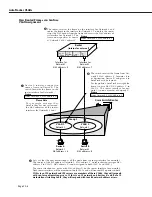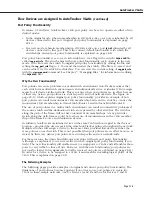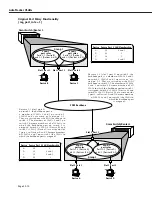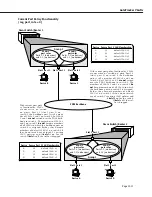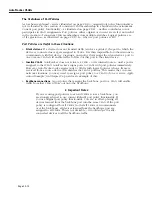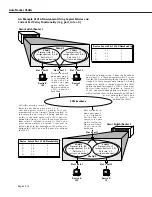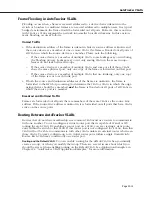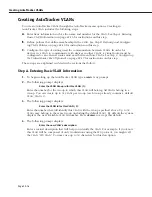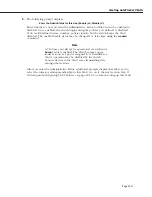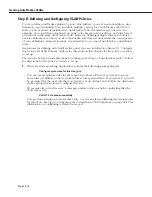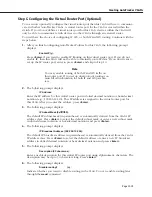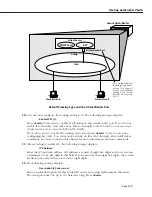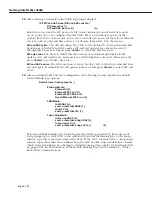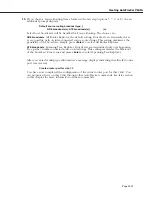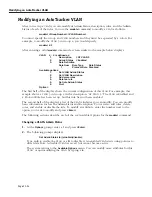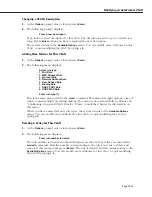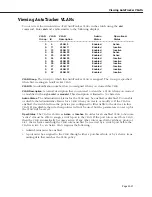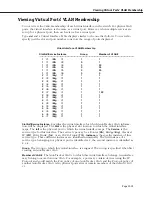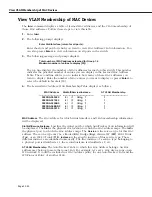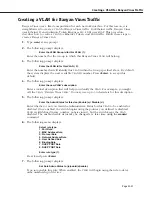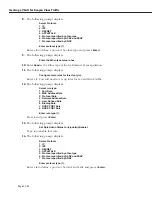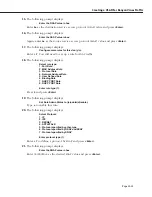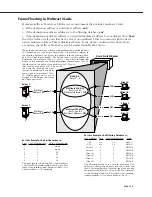
Creating AutoTracker VLANs
Page 22-22
13.
After entering a description, the following prompt displays:
IPX RIP and SAP mode {RIP and SAP active (a)
RIP only active (r)
RIP and SAP inactive (i)}
(a):
Select how you want the
IPX
protocols,
RIP
(router internet protocol) and
SAP
(service
access protocol), to be configured for this
VLAN
.
RIP
is a network-layer protocol that
enables this
VLAN
to learn routes.
SAP
is also a network-layer protocol that allows network
services, such as print and files services, to advertise themselves. The choices are:
RIP and SAP active
. The default setting. The
VLAN
to which this
IPX
router port is attached
participates in both
RIP
and
SAP updates
.
RIP
and
SAP
updates are sent and received
through this router port. Simply press
<Enter>
to select
RIP
and
SAP
active.
RIP only active
.
The
VLAN
to which this
IPX
router port is attached participates in
RIP
updates only.
RIP
updates are sent and received through this router port. Enter an
r
and
press
<Enter>
to select
RIP
only active.
RIP and SAP inactive
.
The
IPX
router port is active, but the
VLAN
to which it is attached does
not participate in either
RIP
nor
SAP updates
. Enter an
i
and press
<Enter>
to select
RIP
only
active.
14.
After selecting the
RIP
and
SAP
configuration, the following prompt displays the default
router framing type options:
Default router framing type for : {
Ethernet Media:
Ethernet II (0),
Ethernet 802.3 LLC (1),
Ethernet 802.3 SNAP (2),
Novell Ethernet 802.3 raw (3),
FDDI Media:
fddi SNAP (4),
source route fddi SNAP (5),
fddi LLC (6),
source route fddi LLC (7),
Token Ring Media:
token ring SNAP (8),
source route token ring SNAP (9),
token ring LLC (a),
source route token ring LLC (b) }
(0) :
Select the default framing type for the frames that will be generated by this router port
and propagated over the
VLAN
to the outbound ports. Set the framing type to the encap-
sulation type that is most prevalent in the
VLAN
. If the
VLAN
contains devices using encap-
sulation types other than those defined here, the
MPX
module must translate those frames,
which slows throughput. See the figure,
Default Framing Type and the Virtual Router Port
on page 22-21 for an illustration of the Default Framing Type and its relation to Virtual
Router Port communications.
Summary of Contents for Omni Switch/Router
Page 1: ...Part No 060166 10 Rev C March 2005 Omni Switch Router User Manual Release 4 5 www alcatel com ...
Page 4: ...page iv ...
Page 110: ...WAN Modules Page 3 40 ...
Page 156: ...UI Table Filtering Using Search and Filter Commands Page 4 46 ...
Page 164: ...Using ZMODEM Page 5 8 ...
Page 186: ...Displaying and Setting the Swap State Page 6 22 ...
Page 202: ...Creating a New File System Page 7 16 ...
Page 270: ...Displaying Secure Access Entries in the MPM Log Page 10 14 ...
Page 430: ...OmniChannel Page 15 16 ...
Page 496: ...Configuring Source Route to Transparent Bridging Page 17 48 ...
Page 542: ...Dissimilar LAN Switching Capabilities Page 18 46 ...
Page 646: ...Application Example DHCP Policies Page 20 30 ...
Page 660: ...GMAP Page 21 14 ...
Page 710: ...Viewing the Virtual Interface of Multicast VLANs Page 23 16 ...
Page 722: ...Application Example 5 Page 24 12 ...
Page 788: ...Viewing UDP Relay Statistics Page 26 24 ...
Page 872: ...The WAN Port Software Menu Page 28 46 ...
Page 960: ...Deleting a PPP Entity Page 30 22 ...
Page 978: ...Displaying Link Status Page 31 18 ...
Page 988: ...Displaying ISDN Configuration Entry Status Page 32 10 ...
Page 1024: ...Backup Services Commands Page 34 14 ...
Page 1062: ...Diagnostic Test Cable Schematics Page 36 24 ...
Page 1072: ...Configuring a Switch with an MPX Page A 10 ...
Page 1086: ...Page B 14 ...
Page 1100: ...Page I 14 Index ...

